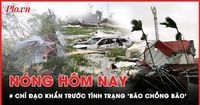On September 30, 2025, as Typhoon No. 10 (Bualoi) battered parts of Vietnam with relentless rain and fierce winds, local authorities, military units, and communities across the country mobilized in a sweeping effort to limit the storm’s damage and protect lives. The coordinated response—marked by early preparation, technical innovation, and community engagement—demonstrated both the vulnerability and resilience of Vietnam’s disaster management systems in the face of increasingly unpredictable weather.
In Gia Lai province, the Provincial Military Command (Bộ CHQS tỉnh Gia Lai) took a proactive stance, deploying disaster prevention and search and rescue measures well before the typhoon’s landfall. According to Bao Gia Lai, the military command worked closely with the Department of Agriculture and Environment to update and supplement disaster prevention and rescue plans, ensuring every member of the Command Board had clear, specific assignments tailored to their roles. This level of detailed planning was vital, as emergencies demand quick, coordinated action—something the province’s leadership was keen to guarantee.
Colonel Nguyen The Vinh, Commander of the Provincial Military Command, emphasized the seriousness with which the unit approached its responsibilities. 22The Provincial Military Command has thoroughly implemented the province's directives, consolidated disaster prevention and rescue teams, and organized drills to ensure readiness,22 he stated, as reported by Bao Gia Lai. The command also directed local defense units and commune-level commands to strengthen their disaster response forces, especially after recent changes in local government structures.
Preparation extended beyond paperwork. The Provincial Military Command organized regular training and drills for officers and soldiers, focusing on both technical readiness and a sense of civic duty. All equipment and vehicles underwent rigorous inspection and maintenance to guarantee they were in optimal condition for rapid deployment. The command maintained a 24/7 operations center via hotline 112, ensuring that information could be received and acted upon at any hour—a critical asset when disaster can strike without warning.
Colonel To Bac, Commander of the Defense Area Command 6 An Nhon Dong, described the unit’s collaboration with local authorities: 22The unit works with communes and wards to proactively assess and list key areas vulnerable to natural disasters. From there, we develop plans to mobilize forces and equipment appropriately, minimizing potential losses,22 he explained to Bao Gia Lai. Such targeted measures, rooted in local knowledge, are essential to effective disaster response.
The Border Guard Command (BĐBP) of Gia Lai province also played a pivotal role. Under the direction of Colonel Tran Tien Hai, the Border Guard Command monitored weather forecasts closely and developed practical, unit-specific plans. In the lead-up to Typhoon No. 10, the command warned and guided 504 vessels away from dangerous areas and ensured 5,206 vessels docked safely. They even fired storm warning flares to alert fishermen at sea, a vivid reminder of the human stakes in every storm. The Border Guard also coordinated with local communities to help residents reinforce aquaculture cages, protecting both livelihoods and lives.
22The Border Guard Command maintains a disaster prevention and rescue force from the provincial to the grassroots level, thoroughly preparing personnel, equipment, and plans to effectively respond to all unusual weather developments,22 Colonel Tran Tien Hai affirmed, as cited in Bao Gia Lai. The commitment was echoed by Colonel Nguyen The Vinh, who noted that all units in the province’s armed forces had prepared well in terms of manpower, equipment, and plans. Their shared goal: to respond effectively to any abnormal weather and minimize damage to people and property.
Elsewhere in Vietnam, the Ministry of Education and Training responded urgently to the rare and dangerous phenomenon of 'storm on storm,' or consecutive typhoons, issuing directives to schools and educational institutions nationwide. As reported by PLO, the ministry’s swift action was part of a broader mobilization, reflecting the gravity of the threat and the need to safeguard students and educational infrastructure during extreme weather.
But disaster mitigation was not just the domain of military and government agencies. In Uong Bi ward, local authorities, businesses, and residents worked together to tackle a longstanding problem: localized flooding caused by blocked drainage canals. From September 24 to 28, 2025, Uong Bi ward launched a concerted effort to dredge and clear 1,250 meters of drainage canals, including a particularly problematic 800-meter stretch in Quang Trung 1 neighborhood. The canal, previously choked by household waste and sediment, had caused frequent flooding during heavy rains, directly impacting residents’ daily lives.
According to Quang Ninh News, the dredging operation was a collaborative affair. The ward’s forces joined with Bac Stone Warehouse Company - Vinacomin, deploying two excavators and four trucks to remove sediment and transport waste. Workers also installed two steel nets at Quang Trung 1 and Quang Trung 7 to block debris from entering culverts and causing blockages. The result? Even as Typhoon No. 10 brought heavy rainfall, residents in the affected neighborhoods no longer faced the anxiety of flooding. Environmental hygiene improved markedly, and community awareness about keeping canals clean rose significantly.
“Thanks to these measures, despite heavy rains influenced by Typhoon No. 10 (Bualoi), residents near the canal area no longer worry about flooding,” Quang Ninh News reported. The local government intends to continue dredging remaining canal sections, aiming for a long-term solution to flooding and a cleaner, greener living environment.
Underlying all these efforts was a shared recognition: disaster preparedness is a collective responsibility. Authorities provided leadership and resources, but the participation of businesses and ordinary citizens was just as vital. In Uong Bi, residents pledged to stop dumping waste into canals, a small act with big consequences for the whole community. In Gia Lai, soldiers and officers not only trained for emergencies but also educated themselves about their responsibilities to the people they serve.
Vietnam’s experience with Typhoon No. 10 (Bualoi) in 2025 offers a window into the country’s evolving approach to natural disasters. Early planning, inter-agency coordination, technical innovation, and community engagement have all played a role in reducing risk and damage. Yet as storms become more frequent and severe, the lessons of this season will likely shape policies and preparedness in years to come. For now, the people of Gia Lai, Uong Bi, and beyond can look back on a moment when preparation, hard work, and solidarity helped weather the storm.




